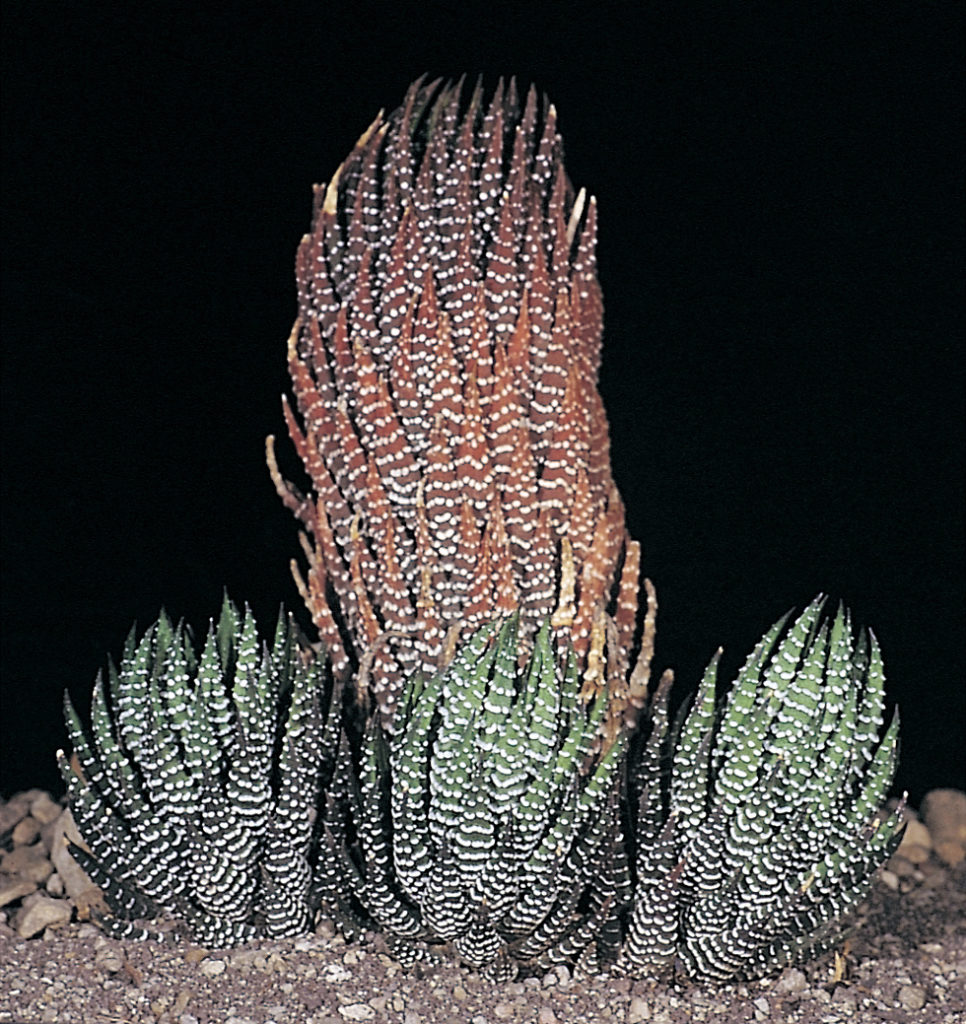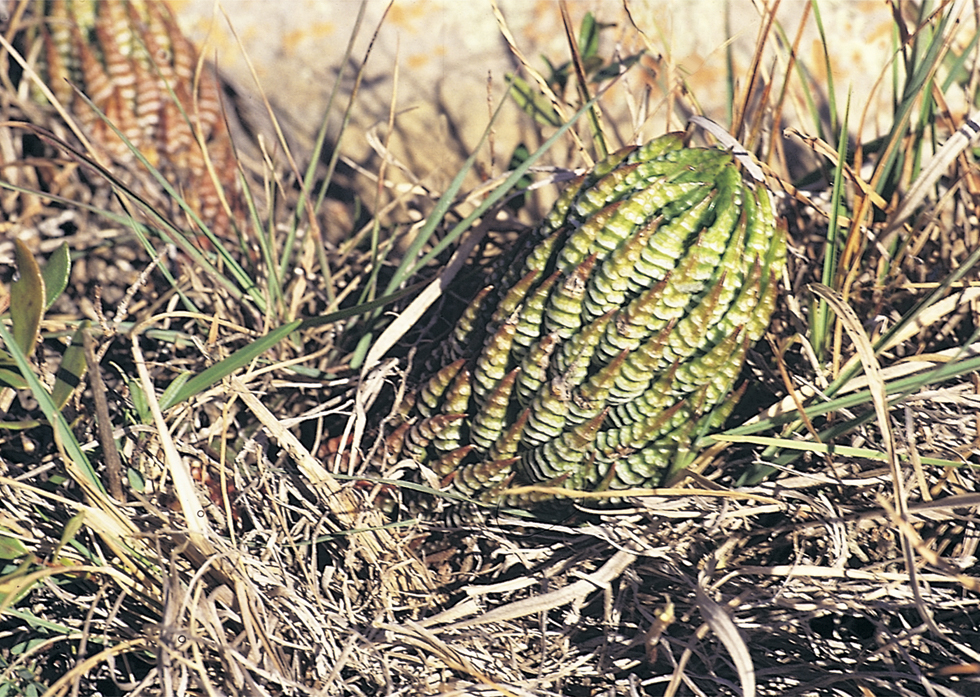52. Haworthia reinwardtii (Salm Dyck) Haw., Revis. :53(1821). V.Poelln., Feddes Repert.Spec.Nov. 41:209(1937). Bayer :149(1976). Scott, Nat.Cact.Succ.J 36:32(1981). Bayer :72(1982). Scott :42(1985). Aloe reinwardtii Salm Dyck, Obs.Bot. :37(1821). Salm Dyck, Monogr. 6:fl6(1836). Type: Not known. Not preserved. Neotype: icon, :f16, Salm Dyck, Monogr.: H. reinwardtii var. major Baker, JLinn.Soc. 18:202(1880). Type: not known. Not preserved: H. reinwardtii var. pulchra V.Poelln., Feddes Repert.Spec.Nov. 41:209(1937). Type: Cape, Kaffirdrift, Long 350. Not preserved: H. reinwardtii var. archibaldiae ibid. :210. Type: Alexandria-Port Alfred Road, Archibald 419. Not preserved: H. reinwardtii var. peddiensis Smith, JS.Afr.Bot. 9:94(1943). Type: Cape, Peddie Div., Smith 656 (NBG): H. reinwardtii var. valida ibid. :98. Type: Cape, Peddie Div., Smith 3342 (NBG): H. reinwardtii var. grandicula ibid. 10:12(1944). Type: Cape, E. Kaffirdrift, Smith 3363 (NBG): H. reinwardtii var. haworthii Res., Mems.Soc.Broteriana: Succ.Afr. 3:79(1943). Type: ex hort, not preserved: H. reinwardtii var. triebneri ibid. :80. Type: ex hort, not preserved:
reinwardtii: after Reinwardt.
Rosette to 100mm φ, caulescent, proliferating. Leaves many, to 70 X 20mm, ratio stem diameter to leaf width 1:1.2, erect spreading or incurved, scabrid, brownish-green, usually with flattened scale-liked tubercles. Inflorescence simple or occasionally compound, to 300mm. Flowers tepals fused, tube straight, inner lower tepals revolute.
1982 – H. reinwardtii is very closely associated with H. coarctata. It occurs southeast of Grahamstown between the Kowie and Fish rivers and eastwards from the Fish River to near East London. The differences between the two species are discussed under H. coarctata. The forms of H. reinwardtii are often more striking than in H. coarctata because of the larger whiter tubercles. The cytology of the species is very interesting (Brandham, 1974) and although fa chalumnensis is maintained here, there are in fact many other triploids and also tetraploids which could be equally recognised. It is difficult to decide precisely what represents the species. The forms olivacea, zebrina and kaffirdriftensis are all from the same very variable population. The fa olivacea when grown in good light is fairly smooth with slender leaves and is a handsome olive‑green. The fa zebrina has bands of confluent tubercles across the back of the leaf, whereas in fa kaffirdriftensis the tubercles are very large and white against a deep green background. Brandham has shown that the genetic make‑up of H. reinwardtii is unusually unstable, and this may explain why this species on its own could be of interest to a collector. It is interesting to consider that a young stemless rosette of H. reinwardtii could easily be confused with H. fasciata, particularly when the inner leaf surfaces are smooth. The leaves in H. attenuata are a little too long and spreading for a similar resemblance to H. reinwardtii plants which have the leaf faces tubercled. Similar associations can be made with H. coarctata. The var. brevicula occurs west of the Fish River in the higher lying areas east of Grahamstown. It is much smaller and more compact than the typical variety.
1999 – Some of the earlier varieties are here only upheld as forms as they were virtually based on single clones. The list of specimens reflects the way in which G.G. Smith tried to observe species. He appeared to be trying to find specimens which differed enough to attract attention. It is not in the least clear where he may have placed the amorphous residue which would have remained after his classification was complete.

a. var. reinwardtii.
Distribution:
3326 (Grahamstown): Fish River valley (-BB), Britten in PRE 34845; 30km from Grahamstown to Peddie (-BD), Britten 143 143a (PRE); Frasers Camp (-BD), Smith 3138 (PRE); Frazers Camp (‑BD), Smith 3138 (NBG): Springtower, Smith 5177 (NBG); 5km NW. Kaffirdrift (-BD), Vosa 2172 (NBG); 3km E. Bushmans River (-DA), Smith 5217 (NBG).
3327 (East London): 21km. E. Huntsdrift (-AA), Smith 656 (NBG, PRE); Near Peddie (-AA), Smith 2742 (NBG), Smith 3363 (BOL); 3km. W. Peddie (-AA), Smith 3334, 3336, 3337 (NBG), Bayer 1391 (NBG); 9km S. Peddie (-AA), Smith 5668 (NBG); 2km E. Wooldridge (-AA), Smith 3333 (NBG); Near Wooldridge (-AA), Smith 3117, 3165, 3166, 3167 (NBG); 5km from Wooldridge (-AA), Smith 5214 (NBG); 2km W. Wooldridge (-AA), Smith 5212 (NBG); Umtana River (-AC), Britten 141 (BOL); Upper Umtana River (-AC), Smith 3376 (NBG); 1km. S. National Road (-AC), Smith 3335 (NBG); 16km NE. of Kafferdrift (-AC), Coetzee in PRE 34824; 11km SW. Peddie (-AC), Smith 3338, 3340 (NBG); 16km SW. Peddie (-AC), Smith 3339, 3341, 3342, 3343 (NBG); 1.5km E. Kaffirdrift (-AC), Smith 3352, 3362, 5274 (NBG); E. side of Kaffirdrift (-AC), Courtenay-Latimer in Smith 3350, 3360 (PRE); 21km SW. Peddie (-AC), Smith 3099, 3100, 3102, 3104, 3346, 3347, 3344, 3348, 3361, 7346 (NBG); E. Kaffirdrift (-AC), Smith 3101, 3103, 3349, 3350, 3351, 3352, 3353, 3354, 3355, 3356, 3357, 3358, 3359, 3360, 3363, 5258, 5259 (NBG), Vosa 2178 (NBG); SE. Kaffirdrift (-AC), Smith 5258, 5260 (PRE); Kaffirdrift (-AC), Smith 2752, 3104, 5264, 5265, 7333 (NBG), Smith 5258 (BOL), Britten 142 (BOL), Courtenay-Latimer in Smith 3363, 3364 (PRE); W. side Kaffirdrift (-AC) Britten 2, 141 (PRE); S. Kaffirdrift (-AC), Smith 657 (NBG); Kap River (-AC), Smith 2998 (NBG); Bell to Wesley (-AD), Smith 3149 (NBG,PRE); Wesley to Falloden (-AD), Smith 3102, 3150, 3151, 3151a, 3153, 3153, 3154, 3155, 3156 (NBG); Near Falloden (-AD), Smith 5662 (NBG); Lower Umtana River (-AD), Smith 5603 (NBG); 5km N. Chalumna (-BA), Smith 5312, 5313, 5314 (NBG); 7km NW Chalumna (-BA), Smith 2776 (NBG); 8km NW. Chalumna (-BA), Smith 2776a (NBG); E. Chalumna (-BA), Smith 2777, 2778, 2779, 3077, 3078, 3079, 3080, 3081, 5316, 5317 (NBG); S. Chalumna (-BA), Smith 3082, 3086, 3087, 3088, 3393, 3394, 3395, 3396, 3397, 3398, 3399 (NBG); W. Chalumna (-BA), Smith 513, 3083, 3084, 3085, 3114 (NBG); Chalumna Causeway (-BA), Smith 513 (PRE), Smith in NBG339/35 (BOL); Kranses, Chalumna River (-BA), Galpin 6289 (PRE); Mt Pleasant (-BA), Smith 3517 (NBG); Ncera River (-BA), Smith 3562, 3563 (NBG), M. Courtenay‑Latimer in NBG68556;; Keiskamma Mouth (-BA), Smith 5133 (NBG); Keiskamma Causeway (-BA), Smith 3148 (NBG); Kidds Beach (-BA), Smith 5209 (NBG); Kayser’s Beach (-BA), Carter (BOL).
Inadequately located: Paardepoort, Peddie, Archibald in NBG1323/32 (NBG); Isidenge, Smith 3572 (PRE); ex hort, Marloth 4211, 5959 (PRE), Kirstenbosch, NBG68164, Smith 3149 (NBG); Albany, Britten in PRE 34838, in PRE 26518; Bathurst, Holland in NBG1833/26 (BOL); Peddie, Dyer 2261a (BOL); .
b. fa chalumnensis (Smith) Bayer :106(1976). Bayer :72(1982). H. reinwardtii var. chalumnensis Smith, JS.Afr. Bot. 9:99(1943). Scott, Nat.Cact.Succ.J 36:38(1981). Scott :45(1985). Type: CAPE‑3327 (Peddie): Chalumna (‑BA), Smith 513 (NBG).
chalumnensis: from Chalumna.
The species occurs all around Chalumna and it is only the triploid vegetatively propagated clone which is this form. It is much easier to grow in cultivation than many of the other clones which have been collected, but which seem never to have survived for long in cultivation.
c. fa kaffirdriftensis (Smith) Bayer :126(1976). Bayer :72(1982). H. reinwardtii var. kaffirdriftensis Smith, JS.Afr.Bot. 9:96(1943). Scott, Nat.Cact.Succ.J 36:37(1981). Scott :44(1985). Type: CAPE‑3327 (Peddie): Kaffirdrift (‑AC), Smith 3364 (NBG).
kaffirdriftensis: from Kaffirdrift.
This variety is probably a single clone is from the east bank of the Fish River and Smith was also intending to name a very similar clone from west of Wesley. The conspicuous tubercles are in longitudinal rows on the back of the leaves.
d. fa olivacea (Smith) Bayer :142(1976). Bayer :72(1982). H. reinwardtii var. olivacea Smith, JS.Afr.Bot. 10:142(1944). Type: CAPE‑3327 (Peddie): Kaffirdrift (‑AC), Smith 5260 (NBG).
olivacea: olive green.
Unlike some of the other forms, this one has an unusual colour and its tubercles are a little rounder and sparser. This character appears to a lesser degree in several clones collected on the west bank of the Fish River. David Cumming also reports the form to be a more substantial element to the southwest.
e. fa zebrina (Smith) Bayer :169(1976). Bayer :73(1982). H. reinwardtii var. zebrina Smith, JS.Afr.Bot. 10:18(1944). Scott, Nat.Cact.Succ.J 36:37(1981). Scott :46(1985). Type: CAPE‑3327 (Peddie): Kaffirdrift (‑AC), Smith 5258 (NBG).
zebrina: striped.
In this form the tubercles are very conspicuous and arranged in prominent white bands on the outer leaf surfaces. The clone does not seem to have survived very well in cultivation and is thus not as vigourous as fa chalumnensis.
f. var. brevicula Smith, JS.Afr.Bot. 10:11(1944). Bayer :104(1976). Bayer :73(1982). Scott, Nat.Cact.Succ.J 36:37(1981). Scott :45(1985). Type: CAPE‑3326 (Grahamstown): Frazers Camp (‑BD), Smith 3138 (NBG): H. reinwardtii var. diminuta Smith, JS.Afr.Bot. 14:15(1948). Type: Cape, Albany Div., Smith 5177 (NBG).
brevicula: very small.
This variety has some substance in terms of variability and distribution. It does not seem to do well in cultivation and is consequently not often seen in collections. Perhaps for the same reason it is not well-known and may transform to some degree in cultivation. Scott does suggest that it occurs mostly as solitary individuals but this is not true as even his photograph shows. The habitat is dominated by graasy fynbos to a lesser degree than in the case of H. coarctata var. adelaidensis. H. coarctata var. huntsdriftensis was, according to Smith’s records, collected very close to the east of Frazer’s Camp where the vegetation also changes to Valley Bushveld.
Distribution: 3326 (Grahamstown): Springtower (-BD), Smith 5177 (NBG); Frazer’s Camp (-BD), Smith 3138, 5117, 5176, 5298, 5299, 5300, 5301, 5664, 7470 (NBG), Bayer 1381, 1382, 1383, 1384 (NBG); 3km W. Frazer’s Camp (-BD), Smith 2901 (NBG); Forestdale (-BD), Smith 5500 (NBG); Top Hunt’s Drift (-BD), Smith 7105, 7106 (NBG).

Haworthia reinwardtii var. reinwardtii JDV94/58 Kaisers Beach. At the eastern limits of the species where tripoids occur. 
Haworthia reinwardtii var. reinwardtii fa. olivacea JDV90/122 Kaffirdrift. These orange colours occur generally and not only in the fa. olivacea. 
Haworthia reinwardtii var reinwardtii fa. chalumnensis Chalumna. Used to occur in a dense colony. 
Haworthia reinwardtii var. reinwardtii fa. kaffirdriftensis Kaffirdrift. With vertical rows of tubercles. 
Haworthia reinwardtii var. reinwardtii fa. zebrina JDV94/118 Kaffirdrift. Even barred forms resembling the fa. zebrina can be “olivaceous”. 
Haworthia reinwardtii var. brevicula JDV97/70 Frazers Camp. A miniaturized form which is not easy to maintain in cultivation.
